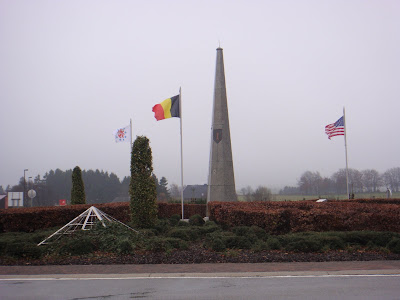Saturday Mickey and I visited the Battle of the Bulge battlefield--or part of it. The thing was huge. You may have read that somewhere. In fact, our guide pointed that out as a feature of mechanized warfare: battlefields are bigger than they used to be--much bigger. Our "guide" was the commander of the unit Rita and I work in. He is a historian who has studied this battle extensively, and he served in the 101st Airborne, which was the US unit that defended the surrounded town of Bastogne, Belgium.

We stopped first at Elsenborn Ridge, where US forces really started to stop the attack. It diverted the German thrust aimed at Liège to the south and constricted the northern shoulder of the advance, basically keeping the bulge a bulge, instead of letting it become the second overrunning of Belgium that Hitler hoped for. This is a monument to the 26th of the 1st--the US 1st Infantry Division, 26th Regiment, which dug in and fought along a ridge line part of which you can see low on the horizon.

Next on the itinerary was a piece of the Siegfried line. These are the "dragon's teeth" tank traps that marked the German border. A two-lane highway runs along the border. Walk across the road, and you're in Belgium.
Third stop was a copse of woods where an isolated recon platoon (maybe that's redundant) fought a battle against a German battalion. As we traveled the battlefield, it started to become clear that the German advance was slowed to no small degree by individual actions by US units of various sizes that were outmanned and outgunned. But not outfought.

The positions from this action are still there--a little eroded, but still there. You could spot the machine gun pits and the foxholes the riflemen dug.
This is the view they had of the German battalion coming at them, only it was covered with snow.
And the little memorial to the men who fought here. It's in some farmer's back yard. A hand-lettered sign on the road points you to it. The farmer has left a corner of his yard for people to park in.

A slightly bigger memorial on which to end. This was erected at the point where the German attack on Bastogne stopped. They got no further. In the center is a stone inscribed, Liberatoribus Americanis populus Belgicus memor. The Belgian people remember the American liberators.



2 comments:
Thanks for describing this batlefield and the Battle of the Bulge so well. This event has always been one of the most fascinating battlss of World War II to me. During the time it was being fought, those of us who were interested (Most Americans) followed the news reports on the radio and they mostly occurred days after the actual event. I was not quite 15 at the time and was not sure but that some day I might be fighting in Europe or in the Pacific. It was a tense time.
These are great! I went to Bastonge after the new year with my friend last year, but we only stayed in town and went to the museum because it was so bitterly cold. I'd love to go back and have a guide like that. That the holes are still there are incredible!
Post a Comment